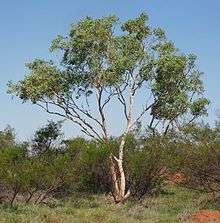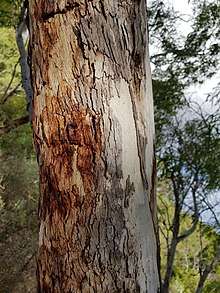Eucalyptus victrix
| Smooth-barked coolibah | |
|---|---|
 | |
| Eucalyptus victrix habit | |
| Scientific classification | |
| Kingdom: | Plantae |
| Clade: | Angiosperms |
| Clade: | Eudicots |
| Clade: | Rosids |
| Order: | Myrtales |
| Family: | Myrtaceae |
| Genus: | Eucalyptus |
| Species: | E. victrix |
| Binomial name | |
| Eucalyptus victrix | |

Eucalyptus victrix, commonly known as the smooth-barked coolibah, western coolibah[1] or little ghost gum,[2] is a species of Eucalyptus which is endemic to Australia.
Description
The spreading tree typically grows to a height of 1 to 12 metres (3 to 39 ft) but can reach as high as 22 m (72 ft). It has smooth bark often with a box-type stocking of rougher bark at the base to a height of 1 m (3 ft). It blooms between November and March producing round white-cream flowers.[3] The tree has an open pendula habit and is slow growing.[2] The small glaucous lanceolate shaped blue-green leaves are covered with a white, waxy bloom.[4] It has terminally held peduncles in groups of seven with conical to rounded operculum.[1]
Distribution
It is found on flats and flood plains in the Mid West, Pilbara, Kimberley and north eastern Goldfields-Esperance regions of Western Australia where it grows in sandy-loamy or clay-sand soils.[3] It is also found through much of the Northern Territory and in far western Queensland.[5] The tree is drought and wind tolerant.[2]
Classification
It was first described by Lawrie Johnson and Ken Hill[6] in 1994 in the work Systematic studies in the eucalypts. A revision of the coolibahs, Eucalyptus subgenus Symphyomyrtus section Adnataria series Oliganthae subseries Microthecosae (Myrtaceae) in the journal Telopea.[5]
Uses
Indigenous Australians traditionally used the tree for many purposes including as a food and water source, weapons, implements, firewood, shade, shelter and for cultural purposes. The Arrente peoples know the tree as ankerre, the Jaru as gurndad and the Pitjantjatjara as ankara.[7]
It is not commonly cultivated but it suitable as a garden ornamental plant which tolerates full sun and is suited to most soil types that are free-draining. It does not usually require pruning except to shape and form.[4] It can be grown from seed and is tolerant to most diseases and pests.[1]
See also
References
- 1 2 3 "Eucalyptus victrix (Western coolibah, Smooth-barked coolibah)" (PDF). Treelogic. Retrieved 17 April 2017.
- 1 2 3 "Eucalyptus victrix 'Little Ghost Gum'". Ellenby Tree Farm. Retrieved 17 April 2017.
- 1 2 "Eucalyptus victrix". FloraBase. Western Australian Government Department of Parks and Wildlife.
- 1 2 "Coolibah Eucalyptus victrix" (PDF). Kings Park & Botanic Garden. Retrieved 17 April 2017.
- 1 2 "Eucalyptus victrix L.A.S.Johnson & K.D.Hill". Atlas of Living Australia. Global Biodiversity Information Facility. Retrieved 17 April 2017.
- ↑ "Eucalyptus victrix L.A.S.Johnson & K.D.Hill". Australian Plant Name Index (APNI), IBIS database. Centre for Plant Biodiversity Research, Australian Government.
- ↑ "Eucalyptus victrix L.A.S.Johnson & K.D.Hill". FloraNT. Northern Territory Government. Retrieved 17 April 2017.